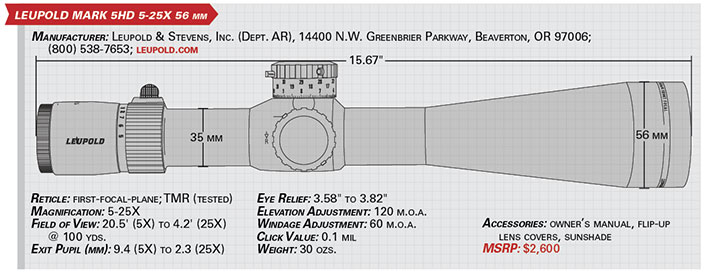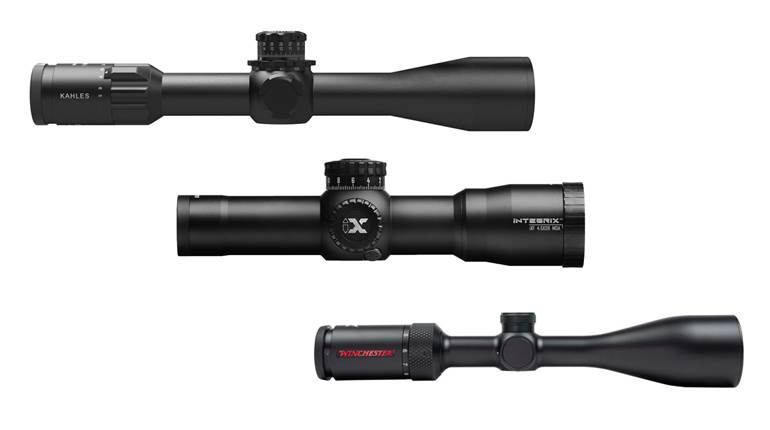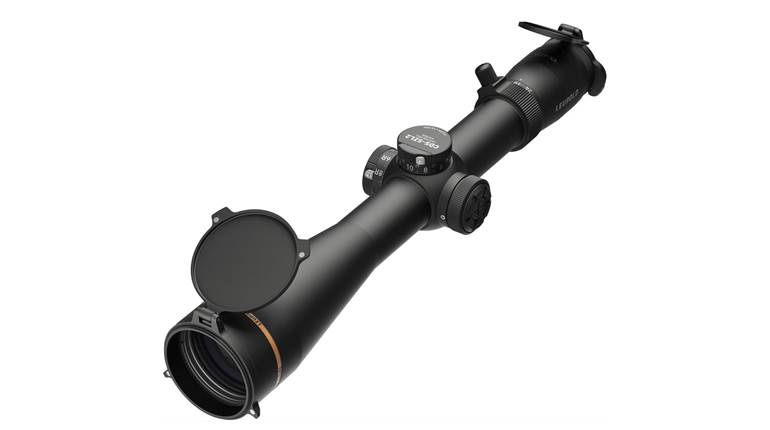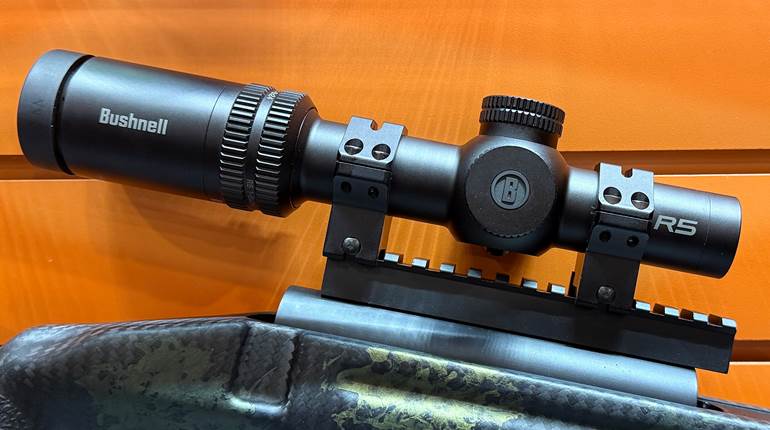
It’s no secret that long-range shooting has become extremely popular in this country. Whether participating in precision rifle competitions, hunting at extended ranges or merely plinking on steel targets, America’s rifleman are interested in shooting farther than ever. Optics, along with a suitable rifle and ammunition, are a key element in the long-range shooting equation, and can often mean the difference between success and failure. To fill this expanding niche, Leupold has developed the Mark 5HD 5-25X 56 mm.
As could be expected, the Mark 5HD 5-25X 56 mm is a big scope; it’s almost 16" long, with much of that length extending forward of the mounting area (or body tube) of the scope. That said, the Mark 5HD is actually a full pound lighter than many other models in the long-range precision category. The main tube is 35 mm in diameter, which means that the current selection of mounts is slim. At the time of this writing, 35 mm mounting solutions are available from Leupold, Badger Ordnance and Geissele. There is a reason for the large tube, though—the ability to dial sufficient elevation adjustment is a key element of long-range shooting. The Mark 5HD’s generous tube diameter gives it an impressive elevation-adjustment range of 120 m.o.a./34.9 mils, and a windage range of 60 m.o.a./17.5 mils.

This optic features a 5:1 magnification ratio, from 5X to 25X, with adjustments made by turning the power ring located just forward of the ocular lens housing. A threaded and removable throw lever gives the user added leverage, a useful feature when making adjustments from field positions. The Mark 5HD’s parallax can be adjusted via a side-focus knob, with seven yardage graduations from 75 yds. to infinity.
The Mark 5HD uses turret-style adjustments for both elevation and windage in 0.1-mil graduations; each click is both audible and tactile. The most efficient method of zeroing this scope is to remove the adjustment turret by loosening the hex screws, which reveals a single flat-blade screw head. Using a screwdriver to make the requisite adjustments makes the process fast and simple, and, once the rifle is zeroed, remounting the turret caps at the “0” position means that the dials are automatically calibrated.

When dialing for elevation, it’s not uncommon for a shooter to lose track of both his zero and the position of his turret—especially when a turret can turn multiple revolutions as this one does. The Mark 5HD provides solutions for both of those potential problems. The first is an adjustable zero stop that prevents the user from dialing below “0” when the turret is installed correctly: When in doubt, dial clockwise until the turret stops. The second issue can arise when dialing for true long range and the shooter isn’t certain how many revolutions the turret has made. On this optic, the turret utilizes a mechanical indicator that provides tactile and visual feedback as to the turret’s position so that it’s useful in any lighting condition.
In order for a scope to be truly useful for long-range shooting, its adjustments must be both reliable and repeatable. To properly evaluate the capabilities of this optic, we mounted it to a Bergara B-14 BMP chassis rifle chambered in 6.5 mm Creedmoor that has proven itself to be capable of consistent sub-m.o.a. accuracy. With a 100-yd. zero established, we fired a test group to set a baseline for the rifle, optic and ammunition.
With a confirmed zero, we then “shot the square” by firing a shot and then dialing either one mil of elevation or windage before firing a subsequent shot and repeating that step in a clockwise direction. This ensures that the scope’s internals tracked accurately and repeatably. If everything goes as planned, the bullet holes on the target form the corners of a perfect box shape. This scope passed that test, so we progressed to an elevation challenge that would simulate a long-range shot: we hung a perfectly level target downrange, calibrated with two dots separated by four mils of elevation. A shot was taken at the lower target, and then the elevation was dialed into the scope to ensure that the point of impact not only moved the correct distance but also that it tracked in a perfectly vertical plane. The Leupold passed this test as well. The scope consistently returned to a precise zero, no matter what adjustments were made—a trait that is not as common as one might assume.
Our test model came equipped with Leupold’s TMR reticle, mounted in the scope’s front focal plane; the CCH, H-59 and Tremor 3 reticles are also available. The TMR uses hash marks to denote windage and elevation holds—these marks occur at 0.5-mil intervals for the first four mils and then transition to 0.2-mil spacing. Because it’s a first-focal-plane reticle, the graduations are calibrated correctly regardless of the magnification setting.
The generous eye box, long eye relief, positive adjustments and intuitive controls made this a very easy scope to master. Clarity was excellent, thanks to the quality of the lenses and their coatings. While optical quality usually ranks below the precision of the adjustments in priority when it comes to long-range shooting, the ability to spot hits and misses downrange is a key attribute, especially in the competitive realm.
This is not a budget-priced scope, and its price tag makes it ineligible for use in the Production Division of the Precision Rifle Series, but it is considerably less expensive than the two most popular precision scopes on the market, so everything is relative. The Mark 5HD is designed, machined and assembled in the United States.
The Mark 5HD 5-25X 56 mm is Leupold’s answer to the premium, long-range precision optics craze, and it follows the Oregon maker’s tradition of being lighter and sleeker than the competition. This is a serious scope for true long-range applications, and, according to our testing, it meets the stringent criteria that those users demand.







































